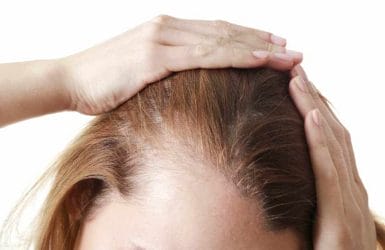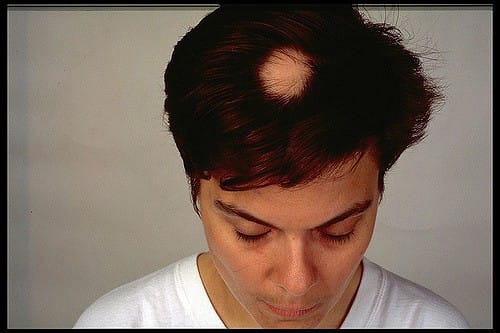
Causes and treatment of baldness in women
Text updated 01.04.2021
When we hear about alopecia, or accelerated hair loss caused by various reasons, it immediately comes to mind a man with increasing baldness. Unfortunately, this problem increasingly often concerns also women, in whom it often has a more dramatic course and more serious consequences, also of psychological nature. Female baldness cannot be simply ignored, it has to be counteracted as soon as its first symptoms are noticed. Research shows that it is already nearly 20 percent of all cases of baldness, and the most common variety we can encounter is androgenic alopecia.
Contents
Female pattern baldness – what are its hard to miss symptoms

Let’s face it, a man with clearances in his hairstyle is a completely normal sight and no one is surprised. The situation is completely different in the case of the fair sex, for whom this is a serious reason at least for growing embarrassment and increasing frustration. Hair loss in women is not only a physical ailment, it leads to stress, which may even turn into severe depression requiring clinical treatment.
Of course, just as often we can encounter a situation in which we overly panic and unnecessarily consider natural hair loss to be a medical condition. After all, about 100 hairs fall out every day, which we find for example on a brush, comb or towel. The problem begins, however, when this number increases in an uncontrollable manner. Everyone who finds himself in such a situation should immediately visit a specialist, a dermatologist or a professional trichologist in order to quickly diagnose the cause of hair loss, which may be really many. Only on such a solid basis you can begin to counteract it, using various methods, from natural to the use of strong pharmaceuticals.
Hair loss in women – the most common types of accelerated hair loss
In case of women, as well as men, we can deal with several types of hair loss, differing from each other in cause, characteristic symptoms, course and treatment of the disease. Usually we encounter the following varieties of hair loss in women:
1. androgenetic alopecia
One of the most difficult to treat and at the same time most common in women, in whom the resulting hair loss concerns from 20 to 60 percent of all cases. It is associated with hormonal imbalance in the body, in which too many male sex hormones, i.e. androgens, headed by testosterone, are produced. As a result of certain unfavorable processes, it begins to convert into dihydrotestosterone, called DHT for short, a variety that quickly weakens and then damages hair follicles.
The reasons for this include genetic predisposition, inherited from an older generation to testosterone mutations, or co-morbidities, often remaining undiagnosed. They do, however, give characteristic symptoms, and gradual hair loss can be caused , for example, by polycystic ovarian syndrome, or thyroid diseases, hyperactive, hypothyroid and Hashimoto. In many cases, this leads to irreversible destruction of hair follicles, which, after all, are the basis for normal hair growth and development, which begin to fall out. Androgenetic alopecia in women may take two forms, differing in the manner and location of hair loss:
- androgenetic alopecia of the female type, in the course of which hair loss occurs in the central part of the head, leaving a small strip of hair only in the forehead area;
- androgenetic alopecia of themale type when hair first begins to fall out in the frontal area, then at the temples and towards the shoulder until only a small amount of hair remains on the top of the head.
2. menopausal alopecia
As the name suggests, hair loss in women occurs during menopause. It is difficult to clearly define the age at which the beginning of the possible onset of this process can be observed, but it usually begins between 45 and 55 years of age and according to studies affects up to 75 percent of all cases of hair loss. In this case, too, it is caused by disorders in hormone secretion caused by the cessation of ovarian function, by which the level of estrogen in the body decreases.
This has a direct and at the same time adverse effect on hair follicles, as a result of which hair becomes weakened and begins to fall out. In contrast to androgenetic alopecia, this process covers the entire surface of the head, and not only certain specific areas such as the hairline or forehead. One of the varieties of menopausal alopecia is scarring alopecia, in which hair loss is associated with a gradual receding of their line, and small but visible scars may form on the skin.
3. alopecia after pregnancy
Also called postpartum alopecia, over 90 percent of women suffer from this condition after giving birth, although its first disturbing symptoms may not appear until several months after delivery. Here, too, as the cause is indicated hormonal disorders related to the amount of estrogen. It increases during pregnancy, and the increased level has a positive effect on hair, which thanks to this is much thicker and stronger, which is immediately visible in the woman and often arouses the admiration of the environment. At the same time, their two phases are stopped, catagen, when the hair begins to gradually die and naturally fall out, and telogen, the regeneration of hair follicles.
So this three-phase cycle is disrupted, and when estrogen levels begin to drop after pregnancy, usually 2 to 3 months after giving birth, those The “over-all” the hair that didn’t fall out during the nine months of pregnancy. They also lose their striking appearance, becoming brittle, fragile, lacking deep color and shine. Another cause of postpartum baldness, which is worth mentioning, is also breastfeeding, associated with an increase in the level of the next hormone, prolactin. It leads to the development of a serious disease, seborrheic dermatitis, and one of its symptoms is just increased hair loss.
Female pattern baldness – everything it can be caused by
With the types of baldness in women described above, we may come across most often and we also already know what factors are responsible for them. However, this is not all that every woman who cares about her hair should be wary of. Hair loss can be caused by other factors, the causes of hair loss are surprising and often due to the fault of the person concerned, such as
Improper diet
Very few people realize the tremendous impact that what they eat has on the health of their hair and scalp. That’s why, when considering the causes of baldness in women, we put diet first, which in many cases is very far from perfect and is one of our own negligence. Hair follicles, bulbs and hair itself need many nutrients for proper growth, which we provide with food and in our daily diet must undoubtedly be found:
Vitamin A
Also known as retinol or beta-carotene, takes an active part in cell formation processes, including skin and hair. It also strengthens the hair by regulating metabolism at the cellular level, especially in the hair follicles and roots. We will provide it with eggs, fatty fish, preferably sea fish, tomatoes, leafy vegetables such as spinach.
B vitamins
Such as B5 (pantothenic acid), B6 (pyridoxine), B7 (biotin), B12 (cobalamin). Without them we cannot count on proper growth of strong and healthy hair, growing out of equally strong and well nourished hair bulb. The most important function here is played by biotin, which strengthens hair, gives it strength, resistance to external factors and prevents hair loss. This group of vitamins can be found in cereal grains, dairy products, poultry meat, banana fruits and nuts.
Vitamin C
That is, ascorbic acid, probably the best known vitamin, with the most precisely described effects. However, it is worth noting that it is a strong natural antioxidant, removing free radicals from the body, which also threaten the health of hair. In addition, it participates in the synthesis of collagen, which is the building material of the skin, prevents iron deficiency in the body by regulating the degree of its absorption, which immediately reflects positively on the condition of the hair. The main source of vitamin C are fruits, not only citrus fruits but also those that grow in our gardens.
Vitamin D
With an extremely wide range of health-promoting effects, and the most important is certainly taking care of the proper work of the immune system. If there are any, even the smallest disorders, it is also visible in the hair, which becomes more susceptible to damage. It is worth taking care of it, because deficiencies are the cause of another dangerous type of hair loss, alopecia areata. It is best to provide vitamin D together with sun rays, and if this is not possible, then let’s drink milk every day, let’s eat products made of it, fish, sea again, or pork liver.
Minerals
Of which two are absolutely essential, silicon and zinc. The former has a positive effect on the condition of blood vessels, which means that the scalp is better supplied with blood and nourished, thus avoiding problems with dry, brittle and fragile hair. Zinc is found in whole grain products, vegetables and fruit. Zinc, in turn, increases the absorption of other nutrients, especially vitamin A, participates in the synthesis of collagen, removes the effects of heavy metals and free radicals. We can get it from yellow rennet cheeses, pumpkin seed oil, cocoa, legumes.
Fatty acids Omega – 3
Their task is primarily to protect hair against the destructive effects of UV radiation, prevent their brittleness and the so unpopular split ends. It is best to provide Omega-3 fatty acids along with healthy oils recommended by nutritionists, sunflower, rapeseed or coconut oil.
Coexisting undetected diseases causing hair loss

They are also the direct cause of rapid and unstoppable hair loss, which is better to prevent in the bud than to struggle for years with its consequences, very severe and often irreversible. Diseases, which should be paid special attention to and regularly examined in this regard, concern
- thyroid gland, producing hormones, whose excess or deficiency immediately reflects on the health and appearance of hair. Usually we are dealing with the so-called hypothyroidism of this organ causing dullness and brittleness of hair, which promotes its loss. With a similar effect we meet with hyperfunction or Hashimoto, so people suffering from these diseases, must constantly monitor their health;
- thedigestive system and practically all of its parts. Disorders of digestion and metabolism have an impact on hair, and many ailments are caused by our own fault, by not eating according to the rules, preferring heavy meals devoid of the above nutrients. Improperly selected weight loss treatment can be equally destructive, especially too rapid weight loss, so it is not worth exaggerating, because the fight against overweight and obesity may also mean a fight against rapidly progressing baldness;
- the circulatory system, which should be checked for possible anemia, which is also related to diet, lack of such an important element as iron in the diet.
Negligence of Hair and Scalp Hygiene
Daily hair and scalp care cannot be based on randomly selected cosmetics that do not match the natural pH value of the hair. If we choose them properly, it can succeed not only in stopping baldness in women, regardless of its type, but also in significantly reversing its effects. This has been shown to be effective even in dealing with the effects of androgenetic alopecia in women, restoring the previous appearance of the hairstyle. Washing hair should become part of our daily life, it should never be forgotten and the choice of shampoos and conditioners available in stores will satisfy everyone’s needs.
Neglected hygiene leads to, among other things, increased seborrhoea and the production of large amounts of sebum, which clogs the follicle openings and prevents hair from growing properly. They are greasy, look unsightly and their surface acts as glue to which bacteria stick, which can cause serious skin diseases that end up in baldness. Therefore, it is worth preventing this, and in the cosmetics used should be the following active ingredients:
- the above-mentioned vitamins and minerals in carefully selected doses;
- substances that safely lubricate the hair, such as jojoba oil or natural glycerine;
- Extracts from plants with beneficial properties for hair health, such as exotic avocado, ginseng or aloe vera, or from plants growing in Polish meadows and gardens, such as nettle, silicon-filled field horsetail, burdock root, fenugreek, thyme, St. John’s wort or black turnip.



